Environmental Impact
Building landfills that safeguard the environment
November 6, 2024
Share

Recipient of the 2024 Gerhard Herzberg Canada Gold Medal, Dr. Kerry Rowe has developed principles and techniques that enable the creation of landfills that can withstand changes in the environment over long periods of time due to factors such as climate change. [Photo credit: NSERC; Sylvie Li Shoot Studio]
Kerry Rowe (Civil Engineering) always tries to instill in his students the idea that research takes time. Some of the projects they work on, he reminds them, have been worked on by multiple graduate students across a decade or more. If a researcher wants to find answers to difficult questions that could change society for the better, it takes patience and perseverance.
Thinking about long durations of time has been central to Dr. Rowe’s work at the Smith Engineering at Queen's University. For more than four decades, he has focused on creating better landfills that can prevent harmful chemicals from seeping into water supplies, not just today but well into the future. Internationally, he has long been recognized as a leader and innovator in the field of geoenvironmental engineering, and now the Natural Sciences and Engineering Research Council of Canada (NSERC) is honouring him with the 2024 Gerhard Herzberg Canada Gold Medal for Science and Engineering.
The Herzberg Medal is considered one of the most prestigious honours awarded to scientists and engineers in Canada. Previous winners include Queen’s Professor Emeritus Arthur McDonald, who went on to become a co-recipient of the 2015 Nobel Prize in Physics, Geoffrey Hinton of the University of Toronto, who was recently named co-recipient of the 2024 Nobel Prize in Physics, and Queen’s Professor John Smol (Biology), who won the Herzberg in 2004.
“I am extremely pleased to be named this year’s Herzberg winner, especially as this is the first time a civil engineer has won the award in thirty years. This is a recognition of a lot of work that my colleagues, my students, and I have done over several decades, so it’s very nice to see that scientific work being recognized.”
– Dr. Kerry Rowe
2024 NSERC Gerhard Herzberg Canada Gold Medal
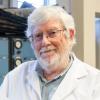
The Herzberg Medal comes with $1 million in research funds over five years for the recipient. Dr. Rowe envisions this new funding will help him pursue his emerging focus on containing the spread of perfluoroalkyl and polyfluoroalkyl substances (PFAS), the so-called forever chemicals that can contaminate water, food, soil, air, and more. PFAS can be found in many consumer products, including cookware, cleaning products, electronics, and vehicles.
“We’ve been using PFAS since the 1940s, in a wide range of products we don’t even think about,” says Dr. Rowe. “Those products will wear out. Now, the trouble is the chemicals in them won’t. And what happens when those products wear out? They go to landfills. So we are accumulating a significant amount of PFAS in landfills that haven’t been designed to contain them. Usually with contaminants, the goal is to keep them below a certain number of milligrams or micrograms per litre of water. But with PFAS, we need to keep them below a certain number of nanograms per litre. This is a challenge on a scale we’ve never encountered before.”
Protecting water from leachate
Dr. Rowe sees this focus on PFAS as a natural extension of his groundbreaking work on designing landfills that prevent contaminants from spreading into the environment. He began this line of research more than forty years ago and has established himself as world leader in the sustainable containment of waste. By aiming to work with nature rather than against it, Dr. Rowe has developed principles and techniques that enable the creation of landfills that can withstand changes in the environment over long periods of time due to factors such as climate change. These innovations also work with the surrounding topography and hydrogeology to prevent contaminants from getting into water supplies.
One of his primary interests has been the development of geomembranes, special plastic liners that can effectively prevent leachate from contaminating soil and water. Leachate is a liquid produced in landfills from the mixture of degrading organic matter and the water that runs through the waste. Along the way, this liquid leaches chemicals from the waste and carries them to the surrounding environment. If leachate is not collected properly, it can pose significant risks to nearby water supplies.

Dr. Rowe examines a geomembrane from one of 53 geosynthetic liner longevity simulators in his lab where pressure up to 3000 kPA is applied to simulate the real-world effects of up to one hundred metres of water sitting on top of a liner to examine its chemical and physical behaviour over time.
Geomembranes are the first line of defence, as they minimize the escape of leachate, but over time this liquid will need to be collected or it will build up and overflow. To this end, Dr. Rowe and his team exposed a classic mistake through their research: the assumption that you can collect leachate using typical water drainage systems. These systems eventually clog up when dealing with leachate, thanks to the bacteria living in it. The bacteria attach themselves to any surface, such on gravel or inside a drainage pipe, where they feed on the chemicals in the leachate. Also the sticky surfaces created by the bacteria cause the accumulation of sand and the cementing of it together with biologically generated calcium carbonate, further restricting the planned flow of leachate to treatment systems.
Developing a sophisticated numerical model backed up with 17 years of large-scale experimental work and field studies, Rowe and his team developed techniques that allow bacteria to do their work of cleaning up the chemicals in leachate, while keeping them keeping them away from the critical components of the collection system.
Landfill liners
Geomembranes are another important area of focus of landfill research. These liners can wear out and break down over time, so, through painstaking experiments that can last decades (his first such test has now been running for 30 years), Dr. Rowe tests their design in real-world conditions. He experiments with full-scale systems using real materials and exposes them to the same stresses and chemical conditions they would face when up and running. While the tests themselves may take decades, temperature can be used to look even further into the future. By testing the entire system, he looks at the components and how they work together, which enables identification of better design techniques and thereby the development of better materials.
Dr. Rowe and his team also upended the assumption of many designers that liners could be built quickly and then be left exposed to the elements, often for years, before being covered by waste in a landfill site. To study this situation, Dr. Rowe’s team, together with substantial industry support, developed Queen’s University’s Environmental Liner Test Site (QUELTS) in 2006. Located 40 km north of Kingston in Godfrey, Ontario, the test site enables Dr. Rowe and his students and colleagues to study exposed geomembranes and determine the effect of weather on their performance. After five years of exposure, in 2011, two thirds of the site was subjected to a thorough exhumation, revealing some critical new findings. This prompted the rebuilding of the site in 2012 with a whole series of new experiments that are still underway. A new section was constructed in 2020 to examine issues related to the melting of permafrost and climate change under accelerated conditions. Dr. Rowe’s goal is always to ensure that a landfill’s system of containment is designed to outlast the contaminants it encloses.
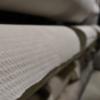
Testing liners at different elevated temperatures for set periods of time, such as a decade, help researchers at Dr. Rowe's lab speed up the effects of time on the liners, informing performance predictions at field temperatures lasting between 100 to 1,000 years.
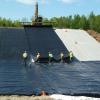
Dr. Rowe also performs further testing at the Queen's University Environmental Liner Test Site field station in Godfrey, ON where students and colleagues can study the behaviour of a full-scale geomembrane installation exposed to weather conditions.
The Halton Landfill in the Niagara Escarpment embodies some of the principles and techniques Dr. Rowe has developed over his career. He has served as a consultant on its development over the past 35 years, and his team has conducted detailed studies of the existing environment and how water behaves in the area. They then designed the landfill taking these findings into account, while also considering how its construction, operations, and ultimately climate change could affect the existing conditions. Overall, this research approach provides the mechanism for those monitoring the landfill’s performance over time to detect and address any unexpected problems and protect the surrounding environment well into the future.
Beyond Canada, Dr. Rowe’s work has led to the adoption of new industry practices and governmental regulations around the world. He has advised on more than 150 projects throughout his career, in locations as far flung as the Arctic and Antarctica. They have provided him with opportunities to solve problems related to environmental protection and have given his graduate students extensive experience with field research.
Over the past fifteen years, Dr. Rowe has also expanded his focus to include containing waste from mining operations. As the growing market for electric vehicles has intensified mining efforts around the world, Dr. Rowe sees this area of research as becoming increasingly pressing in the future.
Mentorship
A renowned mentor, Dr. Rowe also believes his work with students is one of his most significant contributions to engineering. He has advised more than 150 graduate students during his career, and he won the Queen’s University Award for Excellence in Graduate Supervision in 2013. He sees students as major contributors to his research, and he aims to instill principles in them that will set them up for successful careers of their own.
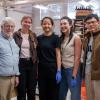
Dr. Rowe with GeoEngineering graduate students (from left to right) Abigail Owens, YU-Yan Li, Farah Barakat, and Felix Fan.
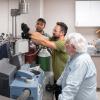
Graduate students (from left to right) Zaid Kasim and Leo Daciolo conduct a test with Dr. Rowe to examine change in polymer length distribution with aging of a geomembrane.
“Students play an absolutely critical role in my research. There’s no way I could do it without them,” says Dr. Rowe. “I also try to train them to make their own contributions by teaching them to identify problems that need to be solved and helping them learn strategies for solving these problems for the betterment of society. I also train them to be patient and persistent, having learned the hard way it can take 20 years from developing a solution to a problem to it being widely accepted as standard practice.”
NSERC Prizes
The Herzberg medal follows two years after Dr. Rowe was named the inaugural recipient of the NSERC Donna Strickland Prize for Societal Impact of Natural Sciences and Engineering Research, which was named after the 2018 Canadian Nobel Laureate in Physics. This year, Queen’s Professor John Smol (Biology) has earned the Donna Strickland Prize.
Learn more about Dr. Smol’s prize on the Queen’s Gazette, and learn more about Dr. Rowe’s research and influence on the Research at Queen’s website and by listening to his interview with CBC's Quirks and Quarks.



